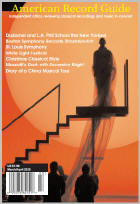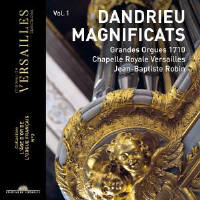Texte paru dans: / Appeared in: Château de Versailles Spectacles
|
|
|
Outil de traduction ~ (Très approximatif) |
|
|
Reviewer: William
J. Gatens
This is the first volume in a
series of the organ works by Jean-François Dandrieu (1681-1738) played on
the organ in the Royal Chapel of the Palace of Versailles by Jean-Baptiste
Robin, the current organist there. Here we have four sets of Magnificat
verses (in D minor, G minor, G major, and A minor) plus an assortment of
individual pieces, including some based on traditional French Noels.
Dandrieu came from a musical
family that hailed originally from Angers, though they had settled in Paris
by the time Jean-François was born. He was a child prodigy who, at an early
age, had music lessons from the composer Jean-Baptiste Moreau (1656-1733).
At the age of 5 Dandrieu performed at court before the Princess Palatine
Elizabeth-Charlotte, the wife of the king’s brother. His first official
appointment was in 1704 as organist of St Merry, a position held by Nicolas
Lebegue until he died in 1702. Dandrieu retained that position until his own
death, though his duties must have been discharged in part by deputies, as
he was also associated with the church of St Barthelemy, where his uncle had
been organist, and above all with the Royal Chapel at Versailles. He was
appointed there in 1721 as one of four organists, each of whom served for a
quarter of the year. Dandrieu’s First Organ Book was published in 1739, the year after he died. The original plan was for two volumes containing 12 suites of pieces, 6 in major and 6 in minor keys. Each suite was to begin with an Offertory followed by several individual pieces and conclude with a set of Magnificat verses. The published volume contains six suites, probably composed between 1705 and 1710. As it happens, the Offertories and several of the other pieces are transcriptions of earlier works for strings. In these, Dandrieu displays the influence of the Italian style, particularly Corelli, and a predilection for fugal counter-point rare among French composers of his day. The Magnificat verses are grounded in the traditions of French liturgical organ composition. Rather than keep the suites entirely intact, Robin devotes the present recording to pieces originally composed for the organ. A later volume in the series will give the transcriptions. The four-manual chapel organ was built by Julien Tribuot and Robert Clicquot according to plans drawn up in 1679 by Etienne Enocq, who had built the organ for an earlier chapel at Versailles. François Couperin played for the inauguration of the new organ in 1711. There were several modifications of the instrument in the later 18th Century. It escaped the French Revolution, though the royal emblems were removed from the case. Further modifications were introduced in 1872 by Aristide Cavaillé-Coll and in 1935 by Victor Gonzalez. The most recent restoration was in 1994 by Jean-Loup Boisseau and Bertrand Cattiaux with the aim of returning the instrument to its specification of 1711. The instrument is beautifully recorded here, with a spaciousness that allows the prominent reeds to be imposing but not oppressive. Jean-Baptiste Robin treats us to some highly animated and stylish playing. The Magnificat verses are suitably dignified, though many have an infectious liveliness. The Noels are charming. I look forward to the coming volumes in the series. It is worth noting an error in the booklet’s track list. A Magnificat verse (Basse de Trompette) from the the D-minor Magnificat is omitted from the movements of that set and listed as the second verse of the G-major Magnificat. That affects the numbering of the iintervening tracks.
| |
|
|
|
|
Cliquez l'un ou l'autre
bouton pour découvrir bien d'autres critiques de CD |
|




